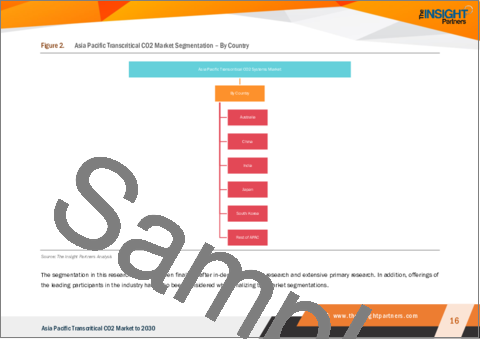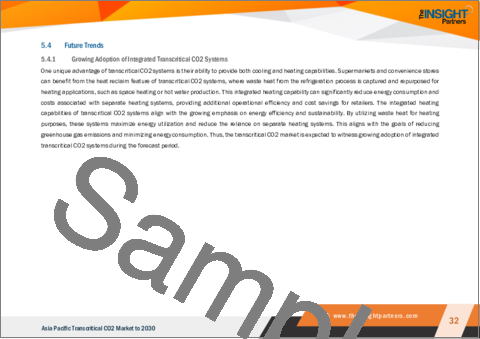|
|
市場調査レポート
商品コード
1452500
アジア太平洋の2030年までの超臨界CO2市場予測- 地域別分析-用途・機能別Asia Pacific Transcritical CO2 Market Forecast to 2030 - Regional Analysis - by Application and Function |
||||||
|
|||||||
| アジア太平洋の2030年までの超臨界CO2市場予測- 地域別分析-用途・機能別 |
|
出版日: 2023年12月19日
発行: The Insight Partners
ページ情報: 英文 112 Pages
納期: 即納可能
|
全表示
- 概要
- 図表
- 目次
アジア太平洋の超臨界CO2市場は、2023年の123億8,095万米ドルから2030年には373億4,672万米ドルに成長すると予測されています。2023~2030年のCAGRは17.1%と推定されます。
アジア太平洋の超臨界CO2市場における高GWP冷媒の悪影響
高GWP冷媒が気候変動に与える悪影響は十分に認識されています。その結果、このような冷媒の使用を段階的に廃止または制限するための国際協定や規制が実施されています。超臨界CO2システムは、GWPが大幅に低い代替手段を提供し、これらの規制を遵守しようとする企業にとって魅力的な選択肢となります。高GWP冷媒からの脱却の必要性は、超臨界CO2システムの市場機会を創出します。スーパーマーケットやコンビニエンスストアは一般的に、生鮮品を保存するために冷蔵システムに依存しているため、環境に大きな影響を与えています。持続可能性と環境への責任がますます重要になるにつれ、これらの冷却システムに関連する二酸化炭素排出量と温室効果ガス排出量を削減する必要性が高まっています。超臨界CO2システムは、従来の冷媒に関連する環境への影響を軽減し、持続可能性の目標に沿うものであるため、持続可能なソリューションに対する需要は、超臨界CO2システムが市場シェアを拡大する機会を提供します。
アジア太平洋の超臨界CO2市場概要
アジア太平洋では、工業化が様々な商業・工業セグメントでの冷暖房ソリューションの需要を促進しています。加えて、厳しい政府の規制と政策が環境に優しい技術を促進し、それが超臨界CO2超臨界システムの採用に拍車をかけています。例えば、2050年と2060年までにカーボンニュートラルを達成するという誓約が高まっています。ESCAP、UNEP、UNICEFの共同評価調査によると、アジア太平洋加盟49カ国のうち39カ国が、カーボンニュートラルとネット・ゼロ・エミッションの達成を約束しています。いくつかの国は、カーボンニュートラルとネットゼロの誓約を達成するために、長期的な低排出開発政策を採用または更新することを期待しています。エネルギー、運輸、都市開発、貿易、投資などのセクターごとに、より野心的なNDCとカーボンニュートラル/ネットゼロの約束を支援するための、深い脱炭素化の道筋が実行・開発されています。したがって、アジア太平洋ではカーボンニュートラルを達成するために、超臨界CO2システムが広く利用されています。
中国、韓国、日本は、世界の食料品セグメントの急速な台頭において重要な役割を果たすことができます。Institute of Grocery Distribution(IGD)によると、アジアの上位12食料品市場におけるオンライン食料品販売は、2023年には198%増の2,950億米ドルに成長すると予想されています。アジアの食料品市場が拡大するにつれ、冷却システムに対する需要も増加し、それが超臨界CO2市場拡大の原動力となると思われます。このように、超臨界CO2システム市場の成長は、有利な政府政策、環境持続可能性への意識の高まり、エネルギー効率の高い冷却・暖房ソリューションへのニーズが原動力となっています。継続的な技術進歩と持続可能な市場開拓への強い注力により、市場は今後さらに拡大すると予想されます。
アジア太平洋の超臨界CO2市場の収益と2030年までの予測(金額)
アジア太平洋の超臨界CO2市場セグメンテーション
アジア太平洋の超臨界CO2市場は、アプリケーション、機能、国にセグメント化されます。
用途別では、アジア太平洋の超臨界CO2市場は、アイススケートリンク、食品加工・貯蔵施設、ヒートポンプ、スーパーマーケット・コンビニエンスストア、その他に区分されます。スーパーマーケットとコンビニエンスストアセグメントが、2023年のアジア太平洋の超臨界CO2市場で最大のシェアを占めています。
機能別に見ると、アジア太平洋の超臨界CO2市場は空調、冷蔵、暖房に区分されます。2023年にアジア太平洋の超臨界CO2市場で最大のシェアを占めたのは、冷凍セグメントでした。
国別に見ると、アジア太平洋の超臨界CO2市場は、オーストラリア、中国、インド、日本、韓国、その他のアジア太平洋に区分されます。2023年、アジア太平洋の超臨界CO2市場は中国が独占。
Baltimore Aircoil Co、BITZER Kuhlmaschinenbau GmbH、Carrier Global Corp、Danfoss AS、Emerson Electric Co、Hussmann Corp、Panasonic Holdings Corp、Mayekawa Manufacturing Co Ltdは、アジア太平洋の超臨界CO2市場で事業を展開している大手企業です。
目次
第1章 イントロダクション
第2章 要点
第3章 調査手法
- カバー範囲
- 2次調査
- 1次調査
第4章 アジア太平洋の超臨界CO2市場情勢
- 市場概要
- アジア太平洋PEST分析
- エコシステム分析
- 専門家の見解
第5章 アジア太平洋の超臨界CO2市場:主要市場力学
- 市場促進要因
- 持続可能な冷却・冷凍ソリューション
- スーパーマーケットとコンビニエンスストアにおける超臨界CO2システムの採用
- 市場抑制要因
- 超臨界CO2システム導入の初期コストの高さ
- 市場機会
- 地球温暖化係数の高い冷媒の悪影響
- 今後の動向
- 統合型超臨界CO2システムの採用拡大
- アジア太平洋における促進要因と抑制要因の影響分析
第6章 超臨界CO2市場-アジア太平洋市場分析
- アジア太平洋の超臨界CO2市場地域概要
- アジア太平洋の超臨界CO2市場~2030年までの収益と予測
第7章 アジア太平洋の超臨界CO2市場分析-用途別
- 概要
- アジア太平洋の超臨界CO2市場:用途別(2022年、2030年)
- アイススケートリンク
- 食品加工・貯蔵施設
- ヒートポンプ
- スーパーマーケット、コンビニエンスストア
- その他
第8章 アジア太平洋の超臨界CO2市場分析-機能別
- 概要
- アジア太平洋の超臨界CO2市場:機能別(2022年、2030年)
- 冷却
- 冷蔵
- 暖房
第9章 アジア太平洋の超臨界CO2市場:国別分析
- 概要
- アジア太平洋の超臨界CO2市場:主要国別
- オーストラリア超臨界CO2市場:2030年までの収益と予測
- 中国超臨界CO2市場:収益と2030年までの予測
- インド超臨界CO2の臨界圧市場:収益と2030年までの予測
- 日本超臨界CO2市場:2030年までの収益と予測
- 韓国超臨界CO2超臨界圧市場:2030年までの収益と予測
- その他のアジア太平洋超臨界CO2市場:2030年までの収益と予測
- アジア太平洋の超臨界CO2市場:主要国別
第10章 業界情勢
- イントロダクション
- 市場イニシアティブ
- 新製品開発
- 合併と買収
第11章 企業プロファイル
- Baltimore Aircoil Co
- BITZER Kuhlmaschinenbau GmbH
- Carrier Global Corp
- Danfoss AS
- Hussmann Corp
- Emerson Electric Co
- Panasonic Holdings Corp
- Mayekawa Manufacturing Co Ltd
第12章 付録
List Of Tables
- Table 1. Asia Pacific Transcritical CO2 Market - Revenue and Forecast to 2030 (US$ Million)
- Table 2. Australia: Transcritical CO2 Market, By Application - Revenue and Forecast to 2030 (US$ Million)
- Table 3. Australia: Transcritical CO2 Market, By Function Type - Revenue and Forecast to 2030 (US$ Million)
- Table 4. China: Transcritical CO2 Market, By Application - Revenue and Forecast to 2030 (US$ Million)
- Table 5. China: Transcritical CO2 Market, By Function Type - Revenue and Forecast to 2030 (US$ Million)
- Table 6. India: Transcritical CO2 Market, By Application - Revenue and Forecast to 2030 (US$ Million)
- Table 7. India: Transcritical CO2 Market, By Function Type - Revenue and Forecast to 2030 (US$ Million)
- Table 8. Japan: Transcritical CO2 Market, By Application - Revenue and Forecast to 2030 (US$ Million)
- Table 9. Japan: Transcritical CO2 Market, By Function Type - Revenue and Forecast to 2030 (US$ Million)
- Table 10. South Korea: Transcritical CO2 Market, By Application - Revenue and Forecast to 2030 (US$ Million)
- Table 11. South Korea: Transcritical CO2 Market, By Function Type - Revenue and Forecast to 2030 (US$ Million)
- Table 12. Rest of APAC: Transcritical CO2 Market, By Application - Revenue and Forecast to 2030 (US$ Million)
- Table 13. Rest of APAC: Transcritical CO2 Market, By Function Type - Revenue and Forecast to 2030 (US$ Million)
- Table 14. List of Abbreviation
List Of Figures
- Figure 1. Asia Pacific Transcritical CO2 Market Segmentation
- Figure 2. Asia Pacific Transcritical CO2 Market Segmentation - By Country
- Figure 3. Asia Pacific Transcritical CO2 Market Overview
- Figure 4. Asia Pacific Transcritical CO2 Market, by Application
- Figure 5. Asia Pacific Transcritical CO2 Market, by Function
- Figure 6. Asia Pacific Transcritical CO2 Market, by Country
- Figure 7. PEST Analysis
- Figure 8. Expert Opinion
- Figure 9. Asia Pacific Transcritical CO2 Market Impact Analysis of Drivers and Restraints
- Figure 10. Asia Pacific Transcritical CO2 Market - Revenue and Forecast to 2030 (US$ Million)
- Figure 11. Asia Pacific Transcritical CO2 Market Revenue Share, By Application (2022 and 2030)
- Figure 12. Ice Skating Rinks: Asia Pacific Transcritical CO2 Market - Revenue and Forecast to 2030 (US$ Million)
- Figure 13. Food Processing & Storage Facilities: Asia Pacific Transcritical CO2 Market - Revenue and Forecast to 2030 (US$ Million)
- Figure 14. Heat Pumps: Asia Pacific Transcritical CO2 Market - Revenue and Forecast to 2030 (US$ Million)
- Figure 15. Supermarkets & Convenience Stores: Asia Pacific Transcritical CO2 Market - Revenue and Forecast to 2030 (US$ Million)
- Figure 16. Others: Asia Pacific Transcritical CO2 Market - Revenue and Forecast to 2030 (US$ Million)
- Figure 17. Asia Pacific Transcritical CO2 Market Revenue Share, By Function (2022 and 2030)
- Figure 18. Air Conditioning: Asia Pacific Transcritical CO2 Market - Revenue and Forecast to 2030 (US$ Million)
- Figure 19. Refrigeration: Asia Pacific Transcritical CO2 Market - Revenue and Forecast to 2030 (US$ Million)
- Figure 20. Heating: Asia Pacific Transcritical CO2 Market - Revenue and Forecast to 2030 (US$ Million)
- Figure 21. Asia Pacific: Transcritical CO2 Market, by Key Country - Revenue (2022) (US$ Million)
- Figure 22. Asia Pacific: Transcritical CO2 Revenue Share, by Key Country (2022 and 2030)
- Figure 23. Australia: Transcritical CO2 Market- Revenue and Forecast to 2030 (US$ Million)
- Figure 24. China: Transcritical CO2 Market- Revenue and Forecast to 2030 (US$ Million)
- Figure 25. India: Transcritical CO2 Market- Revenue and Forecast to 2030 (US$ Million)
- Figure 26. Japan: Transcritical CO2 Market- Revenue and Forecast to 2030 (US$ Million)
- Figure 27. South Korea: Transcritical CO2 Market- Revenue and Forecast to 2030 (US$ Million)
- Figure 28. Rest of APAC: Transcritical CO2 Market- Revenue and Forecast to 2030 (US$ Million)
The Asia Pacific transcritical CO2 market is expected to grow from US$ 12,380.95 million in 2023 to US$ 37,346.72 million by 2030. It is estimated to grow at a CAGR of 17.1% from 2023 to 2030.
Adverse Impact of High Global Warming Potential Refrigerants in Asia Pacific Transcritical CO2 Market
The adverse impact of high GWP refrigerants on climate change is well-recognized. As a result, international agreements and regulations are being implemented to phase out or restrict the use of such refrigerants. Transcritical CO2 systems offer an alternative with significantly lower GWP, making them an attractive option for businesses looking to comply with these regulations. The need to transition away from high GWP refrigerants creates a market opportunity for transcritical CO2 systems. Supermarkets and convenience stores typically have a significant environmental impact due to their reliance on refrigeration systems to store perishable goods. As sustainability and environmental responsibility have become increasingly important, there is a growing need to reduce the carbon footprint and greenhouse gas emissions associated with these cooling systems. As transcritical CO2 systems help mitigate the environmental impact associated with traditional refrigerants and align with sustainability goals, the demand for sustainable solutions presents an opportunity for transcritical CO2 systems to gain market share.
Asia Pacific Transcritical CO2 Market Overview
In APAC, industrialization propels the demand for cooling and heating solutions across various commercial and industrial sectors. Additionally, stringent government regulations and policies promote eco-friendly technologies, which have fueled the adoption of transcritical CO2 systems. For instance, there are rising pledges to achieve carbon neutrality by 2050 and 2060. According to the ESCAP, UNEP, and UNICEF joint assessment study, 39 of the 49 Asia Pacific member states have set commitments to achieve carbon neutrality and net zero emissions. Several nations look forward to adopting or updating their long-term low-emission development policies to achieve carbon neutrality and net-zero pledges. Deep decarbonization sectoral pathways for energy, transport, urban development, trade, and investment are being implemented and developed to support more ambitious NDCs and carbon neutrality/net-zero commitments. Thus, transcritical CO2 systems are widely utilized in APAC to achieve carbon neutrality.
China, South Korea, or Japan can play a significant role in the swift rise of the global grocery sector. According to the Institute of Grocery Distribution (IGD), online grocery sales across Asia's top 12 grocery markets are expected to grow to US$ 295 billion, a 198% increase, in 2023. As Asia's grocery market increases, so will the demand for cooling systems, which will drive the transcritical CO2 market expansion. Thus, the transcritical CO2 systems market growth is driven by favorable government policies, increasing awareness of environmental sustainability, and the need for energy-efficient cooling and heating solutions. With ongoing technological advancement and a strong focus on sustainable development, the market is expected to expand further in the coming years.
Asia Pacific Transcritical CO2 Market Revenue and Forecast to 2030 (US$ Million)
Asia Pacific Transcritical CO2 Market Segmentation
The Asia Pacific transcritical CO2 market is segmented into application, function, and country.
Based on application, the Asia Pacific transcritical CO2 market is segmented into ice skating rinks, food processing & storage facilities, heat pumps, supermarkets & convenience stores, and others. The supermarkets and convenience stores segment held the largest share of the Asia Pacific transcritical CO2 market in 2023.
Based on function, the Asia Pacific transcritical CO2 market is segmented into air conditioning, refrigeration, and heating. The refrigeration segment held the largest share of the Asia Pacific transcritical CO2 market in 2023.
Based on country, the Asia Pacific transcritical CO2 market is segmented int o the Australia, China, India, Japan, South Korea, and the Rest of Asia Pacific. China dominated the Asia Pacific transcritical CO2 market in 2023.
Baltimore Aircoil Co, BITZER Kuhlmaschinenbau GmbH, Carrier Global Corp, Danfoss AS, Emerson Electric Co, Hussmann Corp., Panasonic Holdings Corp, and Mayekawa Manufacturing Co Ltd are some of the leading companies operating in the Asia Pacific transcritical CO2 market.
Table Of Contents
1. Introduction
- 1.1 Study Scope
- 1.2 The Insight Partners Research Report Guidance
- 1.3 Market Segmentation
2. Key Takeaways
3. Research Methodology
- 3.1 Coverage
- 3.2 Secondary Research
- 3.3 Primary Research
4. Asia Pacific Transcritical CO2 Market Landscape
- 4.1 Market Overview
- 4.2 Asia Pacific PEST Analysis
- 4.3 Ecosystem Analysis
- 4.4 Expert Opinion
5. Asia Pacific Transcritical CO2 Market - Key Market Dynamics
- 5.1 Market Drivers
- 5.1.1 Sustainable Cooling and Refrigeration Solutions
- 5.1.2 Adoption of Transcritical CO2 Systems in Supermarkets and Convenience Stores
- 5.2 Market Restraints
- 5.2.1 Higher Upfront Cost of Installing Transcritical CO2 System
- 5.3 Market Opportunities
- 5.3.1 Adverse Impact of High Global Warming Potential Refrigerants
- 5.4 Future Trends
- 5.4.1 Growing Adoption of Integrated Transcritical CO2 Systems
- 5.5 Asia Pacific Impact Analysis of Drivers and Restraints
6. Transcritical CO2 Market - Asia Pacific Market Analysis
- 6.1 Asia Pacific Transcritical CO2 Market Regional Overview
- 6.2 Asia Pacific Transcritical CO2 Market - Revenue and Forecast to 2030 (US$ Million)
7. Asia Pacific Transcritical CO2 Market Analysis - By Application
- 7.1 Overview
- 7.2 Asia Pacific Transcritical CO2 Market, By Application (2022 and 2030)
- 7.3 Ice Skating Rinks
- 7.3.1 Overview
- 7.3.2 Ice Skating Rinks: Asia Pacific Transcritical CO2 Market - Revenue and Forecast to 2030 (US$ Million)
- 7.4 Food Processing & Storage Facilities
- 7.4.1 Overview
- 7.4.2 Food Processing & Storage Facilities: Asia Pacific Transcritical CO2 Market - Revenue and Forecast to 2030 (US$ Million)
- 7.5 Heat Pumps
- 7.5.1 Overview
- 7.6 Supermarkets & Convenience Stores
- 7.6.1 Overview
- 7.6.2 Supermarkets & Convenience Stores: Asia Pacific Transcritical CO2 Market - Revenue and Forecast to 2030 (US$ Million)
- 7.7 Others
- 7.7.1 Overview
- 7.7.2 Others: Asia Pacific Transcritical CO2 Market - Revenue and Forecast to 2030 (US$ Million)
8. Asia Pacific Transcritical CO2 Market Analysis - By Function
- 8.1 Overview
- 8.2 Asia Pacific Transcritical CO2 Market, By Function (2022 and 2030)
- 8.3 Air Conditioning
- 8.3.1 Overview
- 8.3.2 Air Conditioning: Asia Pacific Transcritical CO2 Market - Revenue and Forecast to 2030 (US$ Million)
- 8.4 Refrigeration
- 8.4.1 Overview
- 8.4.2 Refrigeration: Asia Pacific Transcritical CO2 Market - Revenue and Forecast to 2030 (US$ Million)
- 8.5 Heating
- 8.5.1 Overview
- 8.5.2 Heating: Asia Pacific Transcritical CO2 Market - Revenue and Forecast to 2030 (US$ Million)
9. Asia Pacific Transcritical CO2 Market- Country Analysis
- 9.1 Overview
- 9.1.1 Asia Pacific: Transcritical CO2 Market, by Key Country
- 9.1.1.1 Australia: Transcritical CO2 Market- Revenue and Forecast to 2030 (US$ Million)
- 9.1.1.1.1 Australia: Transcritical CO2 Market, By Application
- 9.1.1.1.2 Australia: Transcritical CO2 Market, By Function Type
- 9.1.1.2 China: Transcritical CO2 Market- Revenue and Forecast to 2030 (US$ Million)
- 9.1.1.2.1 China: Transcritical CO2 Market, By Application
- 9.1.1.2.2 China: Transcritical CO2 Market, By Function Type
- 9.1.1.3 India: Transcritical CO2 Market- Revenue and Forecast to 2030 (US$ Million)
- 9.1.1.3.1 India: Transcritical CO2 Market, By Application
- 9.1.1.3.2 India: Transcritical CO2 Market, By Function Type
- 9.1.1.4 Japan: Transcritical CO2 Market- Revenue and Forecast to 2030 (US$ Million)
- 9.1.1.4.1 Japan: Transcritical CO2 Market, By Application
- 9.1.1.4.2 Japan: Transcritical CO2 Market, By Function Type
- 9.1.1.5 South Korea: Transcritical CO2 Market- Revenue and Forecast to 2030 (US$ Million)
- 9.1.1.5.1 South Korea: Transcritical CO2 Market, By Application
- 9.1.1.5.2 South Korea: Transcritical CO2 Market, By Function Type
- 9.1.1.6 Rest of APAC: Transcritical CO2 Market- Revenue and Forecast to 2030 (US$ Million)
- 9.1.1.6.1 Rest of APAC: Transcritical CO2 Market, By Application
- 9.1.1.6.2 Rest of APAC: Transcritical CO2 Market, By Function Type
- 9.1.1.1 Australia: Transcritical CO2 Market- Revenue and Forecast to 2030 (US$ Million)
- 9.1.1 Asia Pacific: Transcritical CO2 Market, by Key Country
10. Industry Landscape
- 10.1 Overview
- 10.2 Market Initiative
- 10.3 New Product Development
- 10.4 Merger and Acquisition
11. Company Profiles
- 11.1 Baltimore Aircoil Co
- 11.1.1 Key Facts
- 11.1.2 Business Description
- 11.1.3 Products and Services
- 11.1.4 Financial Overview
- 11.1.5 SWOT Analysis
- 11.1.6 Key Developments
- 11.2 BITZER Kuhlmaschinenbau GmbH
- 11.2.1 Key Facts
- 11.2.2 Business Description
- 11.2.3 Products and Services
- 11.2.4 Financial Overview
- 11.2.5 SWOT Analysis
- 11.2.6 Key Developments
- 11.3 Carrier Global Corp
- 11.3.1 Key Facts
- 11.3.2 Business Description
- 11.3.3 Products and Services
- 11.3.4 Financial Overview
- 11.3.5 SWOT Analysis
- 11.3.6 Key Developments
- 11.4 Danfoss AS
- 11.4.1 Key Facts
- 11.4.2 Business Description
- 11.4.3 Products and Services
- 11.4.4 Financial Overview
- 11.4.5 SWOT Analysis
- 11.4.6 Key Developments
- 11.5 Hussmann Corp
- 11.5.1 Key Facts
- 11.5.2 Business Description
- 11.5.3 Products and Services
- 11.5.4 Financial Overview
- 11.5.5 SWOT Analysis
- 11.5.6 Key Developments
- 11.6 Emerson Electric Co
- 11.6.1 Key Facts
- 11.6.2 Business Description
- 11.6.3 Products and Services
- 11.6.4 Financial Overview
- 11.6.5 SWOT Analysis
- 11.6.6 Key Developments
- 11.7 Panasonic Holdings Corp
- 11.7.1 Key Facts
- 11.7.2 Business Description
- 11.7.3 Products and Services
- 11.7.4 Financial Overview
- 11.7.5 SWOT Analysis
- 11.7.6 Key Developments
- 11.8 Mayekawa Manufacturing Co Ltd
- 11.8.1 Key Facts
- 11.8.2 Business Description
- 11.8.3 Products and Services
- 11.8.4 Financial Overview
- 11.8.5 SWOT Analysis
- 11.8.6 Key Developments
12. Appendix
- 12.1 About The Insight Partners
- 12.2 Word Index





